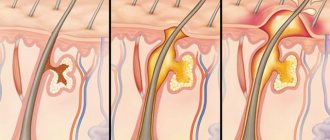Purulent-inflammatory infections of the skin and subcutaneous tissue are damage to a certain layer of the skin, subcutaneous tissue with the involvement of nearby tissues (muscle and mucous layers, fascia and parenchymal tissue). The depth of the lesion depends on the number of pathogens, the size of the affected area and the level of the immune system. A common cause of pyodermatosis and purulent wounds is staphylococcal and streptococcal infections. Pseudomonas aeruginosa, Proteus vulgaris, mycoplasmas, Escherichia coli, etc. are less often involved in the purulent process.
What diseases are there?
Staphylococcal and streptococcal infections include:
- boils,
- carbuncles,
- hidradenitis,
- abscesses,
- purulent wounds with damage to the integrity of the skin.
The most common ways of charging are your own skin, skin folds, subungual area, nasopharyngeal mucosa, as well as contact with an infected person. Reduced immunity is a predisposing factor in the occurrence and development of purulent infections.
Boils
A furuncle is an inflammatory process of the hair follicle of the skin. Staphylococcus aureus is the cause of the disease. Clinically, a boil looks like this: the appearance of a pustule in the form of tension and soreness of the skin in the hair area, with redness of the affected area. The affected area has a clear rounded outline and over time takes on a dark purple color with a purulent grain in the middle. The size of boils reaches from 0.5 cm to 1.5 cm. Favorite localization: neck, face and back. But it can develop on any part of the body.
Carbuncles
A carbuncle is the same boil that involves several hair follicles and sebaceous glands in the process. It has many heads with purulent contents. The cause of development is: staphylococci and streptococci. In terms of the size of the skin lesion, the carbuncle is larger (up to 2.5 cm) and clinically develops more clearly. When developing, a multi-headed carbuncle causes fever and general malaise. The favorite localization of the carbuncle is the skin of the back, shoulders and neck.
Carbuncles often give complications in the form of lymphadenitis, thrombophlebitis, meningitis and the development of sepsis.
Hidradenitis
Hidradenitis (otherwise called “bitch udder”) is a purulent inflammation of the axillary sweat glands, as well as the apocrine glands of the perineal region. The routes of transmission of infection are through lymphatic vessels or damaged skin. The clinical picture begins with the development of a dense nodule accompanied by a painful symptom; a pustule does not form at the site of inflammation and there are no necrotic masses. With myomalacia of the affected area, pus comes out in the form of a fistula. If several glands are involved in the process, they merge. Intoxication increases with increasing temperature, malaise, etc.
Abscesses
An abscess is an infectious and inflammatory process involving the skin layers and subcutaneous tissue, with the formation of a purulent “sac”. The causes of abscesses are very different: superficial and deep injuries, hematomas involving secondary infection, post-injection complications, furunculosis, carbuncles, etc. Accompanied by pain in the developmental area, as well as increased temperature and fever.
Purulent wounds
A purulent wound is damage to the integrity of the skin (deep or superficial) with the addition of staphylococcal and streptococcal infections. Wounds of this kind do not have a specific localization due to the spontaneity of the occurrence of injuries of various etiologies (mechanical, chemical or somatic origin).
1. BASIC CONCEPTS Website is a personal website (indicate the affiliation of the site), located on the Internet at the address: www.begma.ru. Site Administration – IP Smirnova Lyudmila Petrovna644 048 Omsk, st. Angarskaya 2 sq. 8. User – an individual or legal entity who has posted his personal information through the Feedback Form on the site with the subsequent purpose of transferring data to the Site Administration. Feedback form is a special form where the User places his personal information for the purpose of transferring data to the Site Administration. 2. GENERAL PROVISIONS 2.1. This Privacy Policy is an official standard document of the Site Administration and determines the procedure for processing and protecting information about individuals and legal entities using the Feedback Form on the Site. 2.2. The purpose of this Privacy Policy is to ensure adequate protection of information about the User, incl. his personal data from unauthorized access and disclosure. 2.3. Relations related to the collection, storage, distribution and protection of information about users are governed by this Privacy Policy and the current legislation of the Russian Federation. 2.4. The current version of the Privacy Policy is a public document, developed by the Site Administration and is available to any Internet User by clicking on the “Privacy Policy” hypertext link. 2.5. The Site Administration has the right to make changes to this Privacy Policy. 2.6. When changes are made to the Privacy Policy, the Site Administration notifies the User by posting a new version of the Privacy Policy on the Site www.begma.ru. 2.7. When a new version of the Privacy Policy is posted on the Site, the previous version is stored in the documentation archive of the Site Administration. 2.8. By using the Feedback Form, the User agrees to the terms of this Privacy Policy. 2.9. The Site Administration does not verify the accuracy of the information received (collected) about the User. 3. CONDITIONS AND PURPOSE OF COLLECTION AND PROCESSING OF USERS' PERSONAL DATA 3.1. Personal data of the User such as: first name, last name, patronymic, e-mail, telephone, skype, etc., are transferred by the User to the Site Administration with the consent of the User. 3.2. The transfer of personal data by the User to the Site Administration through the Feedback Form means the User’s consent to the transfer of his personal data. 3.3. The Site Administration processes information about the User, incl. his personal data, such as: first name, last name, patronymic, e-mail, telephone, skype, etc., as well as additional information about the User provided by him at his own request: organization, city, position, etc. in order to fulfill obligations to User of the Site. 3.4. The processing of personal data is carried out on the basis of the principles: a) the legality of the purposes and methods of processing personal data and good faith; b) compliance of the purposes of processing personal data with the goals predetermined and stated when collecting personal data; c) compliance of the volume and nature of the processed personal data with the methods of processing personal data and the purposes of processing personal data; d) the inadmissibility of combining databases containing personal data created for incompatible purposes. 3.5. The Site Administration processes the User’s personal data with his consent for the purpose of providing services/selling goods offered on the Site. 4. STORAGE AND USE OF PERSONAL DATA The User’s personal data is stored exclusively on electronic media and is used strictly for the purpose specified in clause 3 of this Privacy Policy. 5. TRANSFER OF PERSONAL DATA 5.1. The User's personal data is not transferred to any third parties, except for the cases expressly provided for in this Privacy Policy and specified in the Consent to the newsletter.
5.2. The provision of the User’s personal data at the request of state bodies and local governments is carried out in the manner prescribed by the legislation of the Russian Federation. 6. STORAGE TERMS AND DESTRUCTION OF PERSONAL DATA 6.1. The User’s personal data is stored on the website’s electronic media indefinitely. 6.2. The User’s personal data is destroyed at the request of the User himself based on his request, or at the initiative of the Site Administrator without explanation, by deleting the information posted by the User by the Site Administration. 7. RIGHTS AND OBLIGATIONS OF USERS Users have the right, upon request, to receive from the Site Administration information regarding the processing of their personal data. 8. MEASURES TO PROTECT USER INFORMATION The Site Administrator takes technical, organizational and legal measures to ensure the protection of the User’s personal data from unauthorized or accidental access to it, destruction, modification, blocking, copying, distribution, as well as from other unlawful actions. 9. USER REQUESTS 9.1. The User has the right to send his requests to the Site Administration, incl. regarding the use/deletion of his personal data, provided for in clause 3 of this Privacy Policy in writing to the address specified in clause 1. 9.2. The request sent by the User must contain the following information: for an individual: – number of the main document identifying the User or his representative; – information about the date of issue of the specified document and the issuing authority; – date of registration via the Feedback Form; – text of the request in free form; – signature of the User or his representative. for a legal entity: – request in free form on company letterhead; – date of registration via the Feedback Form; – the request must be signed by an authorized person accompanied by documents confirming the person’s authority. 9.3. The Site Administration undertakes to consider and send a response to the User's request within 30 days from the date of receipt of the request. 9.4. All correspondence received by the Administration from the User (applications in written/electronic form) refers to restricted information and is not subject to disclosure without the written consent of the User. Personal data and other information about the User who sent the request cannot be used without the special consent of the User other than to respond to the topic of the received request or in cases expressly provided for by law.
Symptoms and causes, what to look for
Furunculosis and carbunculosis are serious pathological phenomena. Symptoms include general malaise and fever. Over time, the patient's general condition may worsen. Inflammation takes on a wide scale. The necrotic process can involve nearby tissues, penetrating deeper into the subcutaneous tissue and muscles, and pus can spread throughout the fascia. This is fraught with purulent meningitis, peritonitis and sepsis. When pustules with purulent contents appear, surgical intervention is necessary.
Hidradenitis, abscess and purulent wounds do not require delay, but immediate surgical treatment. These infectious diseases quickly cause complications, especially in patients with reduced immunity (patients with diabetes mellitus, lymogranulomatosis, tuberculosis, anemia, etc.).
Diagnosis of a boil
The boil appears in the form of a “pimple” with inflammation around it; in the center you can usually see a “rod” (inflamed hair follicle). Inflammation quickly increases and in the absence of proper treatment of the boil, an abscess forms in the underlying tissues, i.e. the boil becomes abscessed. At this stage, surgical treatment of the boil is necessary.
The photo shows an abscess boil of the left thigh.
The photo below shows a femoral boil. Against the background of redness and infiltration, three purulent “heads” are visible. With further spread of the process and lack of treatment, such a boil can turn into a carbuncle.
In some cases, boils appear frequently, in different parts of the body. This condition is called furunculosis. In case of furunculosis, it is necessary to be examined by a surgeon, dermatologist, immunologist, and endocrinologist to find the causes that caused this disease.
The most dangerous are boils on the face, especially those located above the nasolabial fold. The fact is that with this location of the boil there is a risk of developing meningitis.
Treatment methods. Modern methods (opening and drainage of the pathological process)
With a scalpel
Boils, carbuncles, hidradenitis, abscess after pre-treatment with antiseptics are opened using a scalpel, followed by removal of necrotic masses and treatment of wounds with disinfectant solutions. After cleansing, the wound is drained.
CO2 laser
This method is based on carbon dioxide and is widely used in the removal of purulent-inflammatory processes, with minimal burns. After this intervention, the skin does not form scars or depigmentation. This method has virtually no contraindications.
Radio wave method using the Surgitron apparatus
An ideal method for the treatment of boils, carbuncles, abscesses, hidradenitis and purulent wounds. The method is based on the effect of high-frequency waves on the affected area. Bloodlessly removes all pathological tissue with micron precision. After the intervention there is no swelling, redness and no scars.
Local physiotherapy
Local physiotherapy is aimed at increasing the skin's resistance to the infectious agent. The post-operation area, when exposed to physiotherapeutic procedures, quickly forms granular tissue with an obstacle to tissue sclerosis.
Systemic physical therapy (intravenous ozone therapy, ILBI, intravenous ultraviolet blood irradiation)
This procedure is appropriate for repeated furunculosis, carbunculosis and post-infectious complications. Autohemotransfusion using treated venous blood using special technology gives excellent results in case of relapses of pyodermal origin. There is regeneration of blood cells and an impulse to strengthen the immune system.
Treatment of a boil
In the initial stages, the boil can be treated conservatively - antibiotics are used internally, semi-alcohol bandages, injecting the boil with anesthetics mixed with an antibiotic while simultaneously removing the purulent-necrotic core.
When abscessing a boil, i.e. when a cavity with pus forms in the underlying tissues, treatment is only surgical: under local anesthesia, a small (0.3 to 1-2 cm) incision is made in the projection of the abscess, the cavity is sanitized with antiseptics and drained with a gauze strip or a rubber glove.
More information about the tactics of treating boils can be found here<.
If you are unable to work during the treatment of a boil, you can receive a sick leave certificate.
One of the common mistakes in the treatment of a boil is the use of Vishnevsky ointment or ichthyol, which leads to the progression of a purulent process with the rapid formation of an abscess, and in the absence of proper treatment - phlegmon.
IMPORTANT! With a boil, the purulent process can spread quite quickly, turning into abscess formation; with inflammation of neighboring follicles, a carbuncle can develop. In this regard, early contact with a surgeon allows treatment to be carried out in the initial stages of the disease, quickly, without large incisions and pain. If treatment is delayed, there is a high probability of complications, fraught with large incisions and lengthy treatment - see clinical example.
Treatment of children with furunculosis and abscesses
For a correct prognosis and timely follow-up therapy, it is necessary to differentiate an abscess from a boil, abscessing lymphadenitis and suppurating atheroma or congenital cyst.
Treatment of patients with furunculosis and abscesses is only surgical.
Superficial abscesses in children of older age groups can be opened under local anesthesia. It must be remembered that infiltration of inflamed tissues with anesthetic causes severe pain. Abscesses located deep in the tissues and abscesses in children of younger age groups should be opened under general anesthesia.
In case of deep abscesses and a tendency to spread edema, a course of general therapy is carried out, the intensity of which is determined by the age of the child and the nature of the process.
Where to go for help in Saratov?
The First Children's Medical Center uses open and closed surgical treatment of abscesses. The closed method is performed through a small incision. The open method of treatment involves releasing the purulent mass and washing the abscess with an antiseptic after its wide dissection.
Pediatric surgeons at the First Children's Medical Center are highly qualified specialists who are ready to perform the necessary operation on your child if there are medical indications.
The operating unit of the Center is equipped with advanced equipment. After the operation, the child is observed during the day in a day hospital, and then sent home without the risk of complications.
Appointments with a pediatric surgeon are carried out by appointment. Contact us by phone (8452) 244-000.
Symptoms of carbuncle
Clinical signs of a carbuncle are:
- suppuration and wound formation;
- hyperemia of the skin around the lesion;
- severe pain in the entire affected area.
The appearance and development of a carbuncle is usually accompanied by the following symptoms:
- elevated temperature, which often reaches 40 degrees;
- major intoxication;
- vomiting;
- nausea;
- loss of appetite;
- headache;
- general malaise.
These signs are especially pronounced when the carbuncle appears on the face or neck.
There are 3 stages of carbuncle:
Stage 1: infiltrate (folliculitis)
During this period, nodes form under the skin, which will be represented by inflamed hair follicles. The infiltrate contains adipose tissue, pus, lymph and lymphocytes. Nodules rise above the surface of the skin.
Since the nutrition of the dermis is disrupted, it acquires a bluish color. After a few days (from 9 to 12), the infiltrate reaches impressive sizes. It can be about 10 cm in diameter. The skin is swollen, tense, and hot to the touch. The more swelling there is, the more intense the pain will be.
Stage 2: purulent formation
At the stage of suppuration, the carbuncle reaches maturity. Blisters form on it, which are filled with pus. They open, so the surface of the carbuncle resembles a sieve. Through these small holes, pus leaks out, mixed with blood and dead epithelium.
The suppuration stage lasts about 14-21 days. During this period, the patient’s general health deteriorates.
Stage 3: necrosis and tissue rejection
During this period, pus from the carbuncle stops oozing. At the site of inflammation, ulcers are formed that will have rods. They merge with each other, forming one large defect. Tissue damage is very intense and often involves muscles. The affected area is black.
The wound heals slowly, gradually filling with granulations. A scar remains in its place. The necrosis stage lasts about 21 days.










